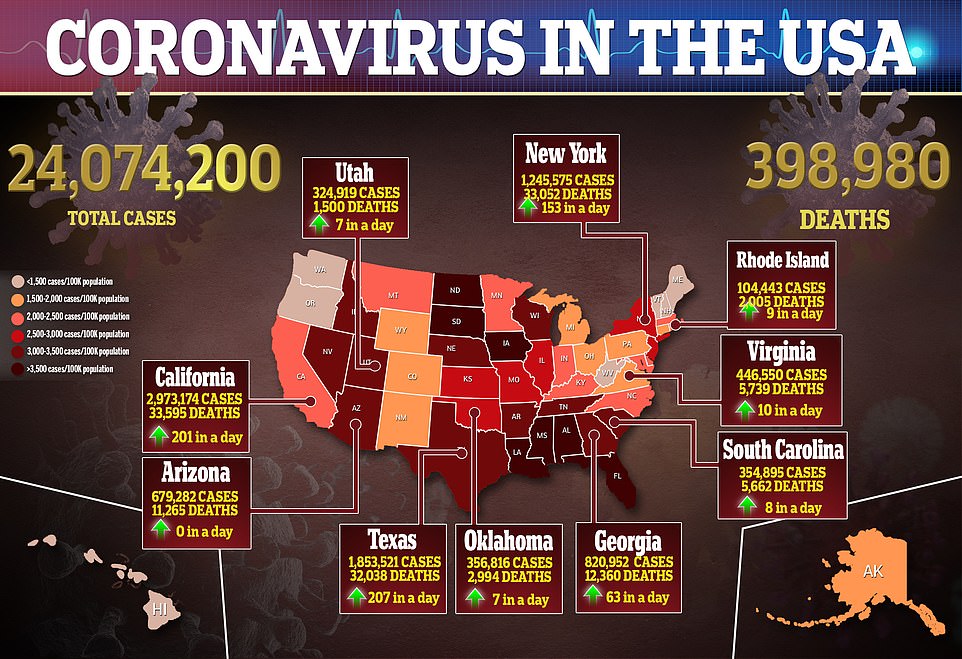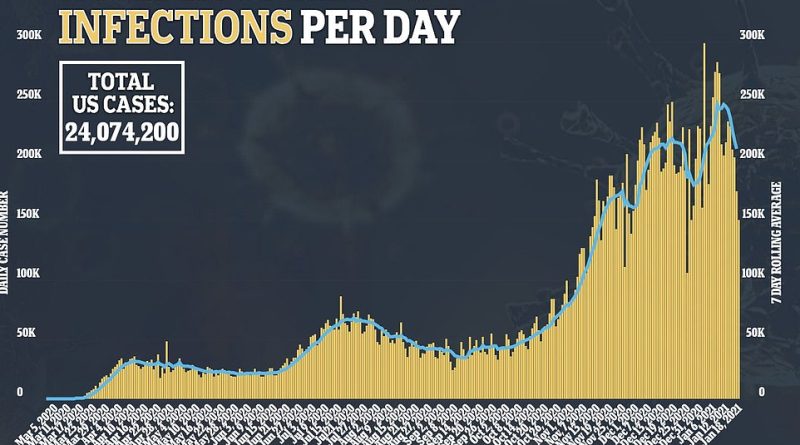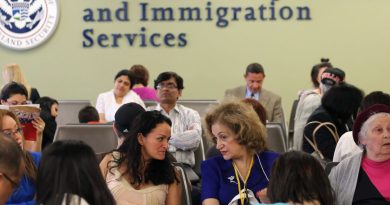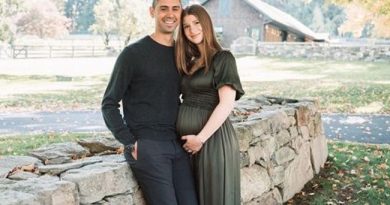COVID cases are down 11% across the US, deaths are dropping in 18 states
New cases of COVID-19 are down nearly 11 percent across the United States with deaths dropping in 18 states, Johns Hopkins University data released Monday shows.
A total of 35 states have seen a decline in the number of people testing positive in the last seven days with 1.5 million Americans told they had the virus over the past week, CNN reports.
And Dr Anthony Fauci told church leaders he predicts congregations will be ‘back singing inside churches by fall’ as long as the US can vaccinate ‘appropriately, effectively, and efficiently’.
He said that ‘the level of virus in the community will be at such a low level’ once the vast majority of the population has received the jab ‘that we will be able to really approach a degree of normality that’s similar, maybe not identical, but similar to where we were before all of this’.
Only a little over 14 million Americans have been vaccinated against COVID-19 as of Monday morning, and only about 54 percent of vaccine doses distributed to states have been administered to people, according to data from Bloomberg.
And warning against drawing too much optimism from the data which shows deaths and cases dropping infectious disease expert Dr. Amesh Adalja said: ‘These kinds of fluctuations, on a statistical basis, aren’t sustainable.
‘The virus has established itself in the human population and it’s not going anywhere. We’re going to see a lot of transmission until we cross the threshold for herd immunity. There has not been enough vaccination to see a full effect nationally.’
New COVID cases averaged about 218,000 a day over the past week; that figure has ranged from 101,000 to 302,000 in the past month.
Dr. Edison Liu of The Jackson Laboratory said the broader trends could mean the US is starting to flatten the curve. Dr Liu said: ‘Flattening the curve means we’ve stopped the exponential rise of infection; that whatever intervention we have worked. But that’s only the first step. What we’re really looking for is a consistent downward trend.’
There were 123,848 people currently hospitalized with COVID-19 as of Monday and an additional 1,393 deaths, the COVID tracking project reports. More than 24 million Americans have tested positive for the virus; nearly 400,000 have died.
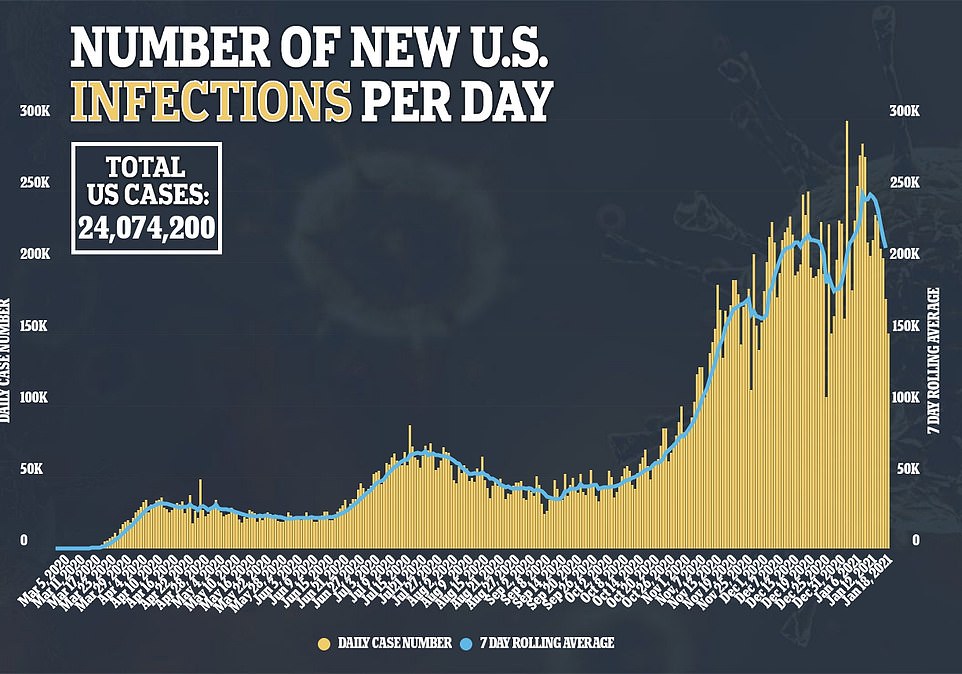
New cases of COVID-19 are down nearly 11 percent across the United States with deaths dropping in 18 states
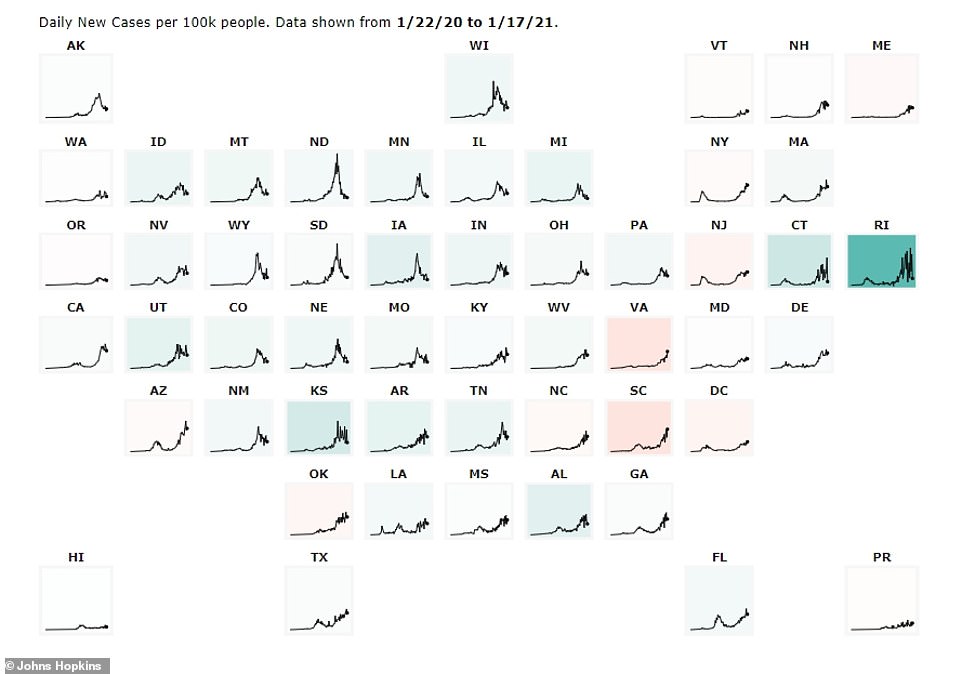
A total of 35 states have seen a decline in the number of people testing positive in the last seven days. John Hopkins say of this graph: ‘The greener the background, the bigger the downward trend of new cases in this state. The redder the background, the bigger the upward trend of new cases in this state’
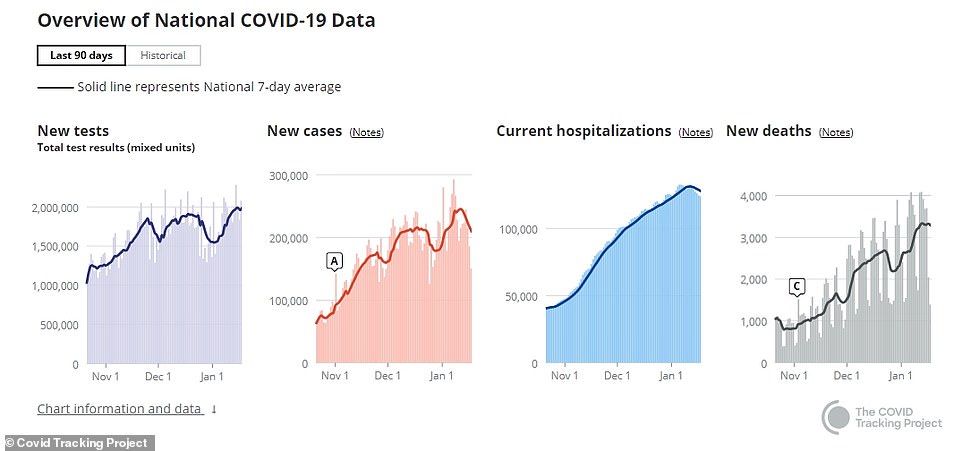
There were 123,848 people currently hospitalized with COVID-19 as of Monday and an additional 1,393 deaths, the COVID tracking project reports. More than 24 million Americans have tested positive for the virus; nearly 400,000 have died
North Dakota has emerged as America’s unlikely leader in the battle against the coronavirus, racing ahead of most of the nation in the vaccine rollout and battling back from being the worst COVID hotspot in the nation with an 80 percent decline in active cases since mid-November.
And while some states like California are floundering with vaccination rollout, using a meager 37 percent of doses distributed to it, North Dakota is flying through the doses sent to it by the federal government, using 78 percent of its allotted doses and vaccinating just shy of seven percent of its population.
State officials acknowledge that North Dakota’s small population size is an advantage. But it also gave health care workers a head-start with training before vaccine doses arrived, and has set up a flexible plan to let people 65 or older, people with two or more underlying conditions, and child care and school workers get priority access to vaccines.
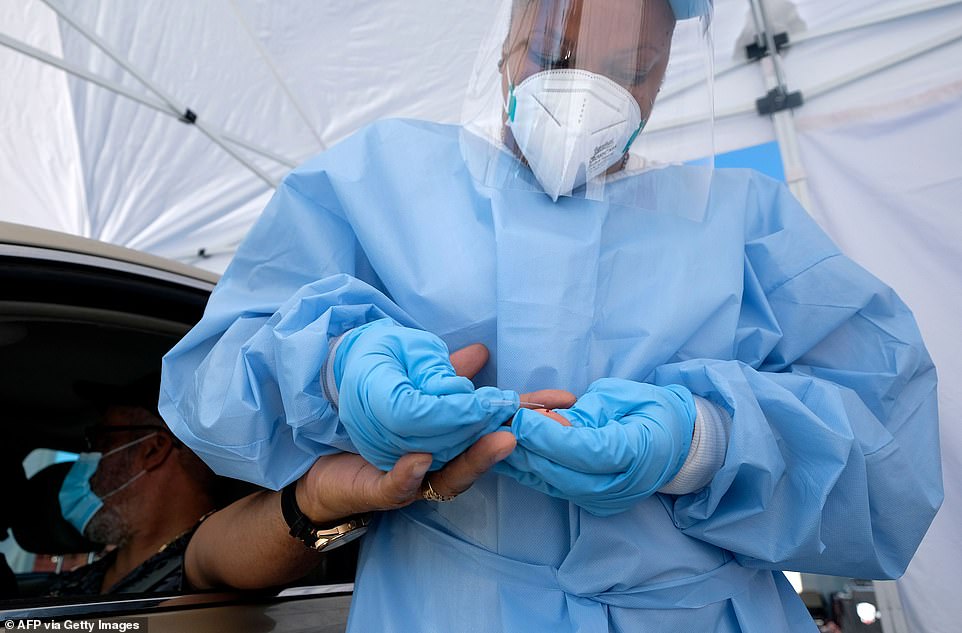
States like California are floundering with vaccination rollout, using a meager 37 percent of doses distributed to it. A healthcare worker draws blood from a motorist at the Southside Church of Christ in Los Angeles, California, on Monday as free rapid Covid-19 antibody and PCR tests are administered
California and New York may be known for their top-notch hospitals and medical schools, but they are struggling to get people vaccinated amid the COVID-19 crisis.
New York Governor Andrew Cuomo has blamed the federal government for his state only getting 5.14 percent of its population vaccinated by Monday, and asked for federal permission to order doses directly from Pfizer.
But the Empire State has only used a little over half (53 percent) of what the Trump administration has shipped to it, and its stiff plan for prioritizing people saw precious doses of vaccine thrown out earlier this month.
California lags even further behind, vaccinating just 3.3 percent of its population with the massive allotment of 3.5 million doses sent to it by the federal government.
And in Florida, which was the third state to reach one million COVID-19 cases, more than 40,000 people are overdue for their second dose of COVID-19 vaccine – a worrying sign that poor organization could leave at-risk residents unprotected.
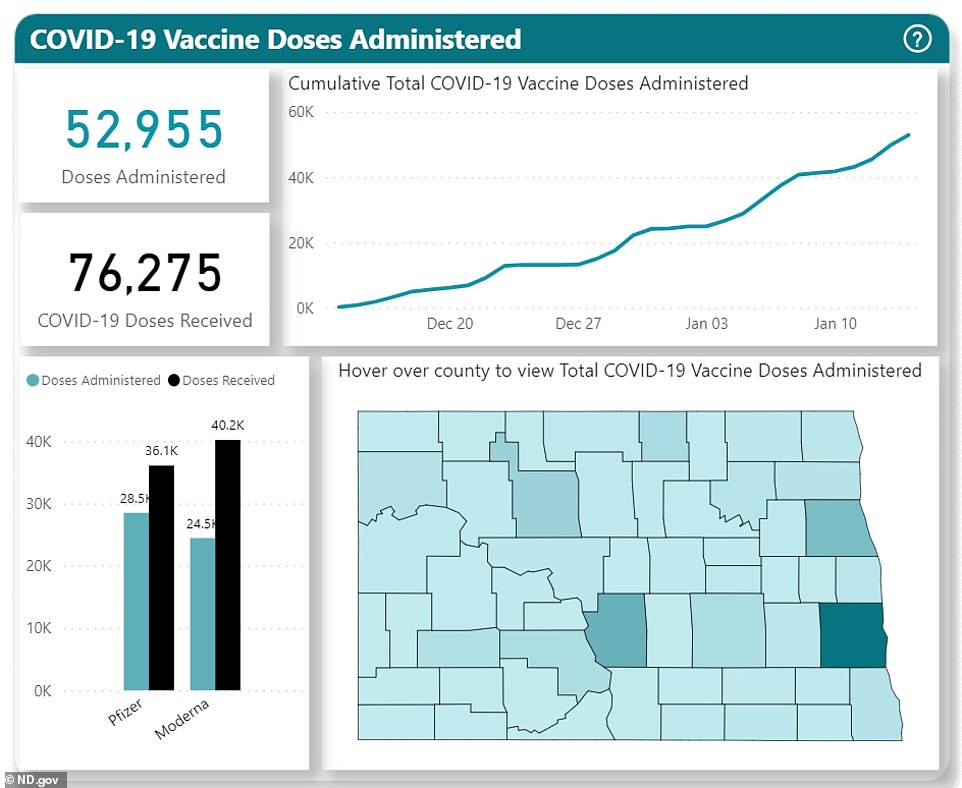
North Dakota has given nearly 53,000 of the 76,275 doses sent to it, and kept up a consistent flow of administering vaccines since its first doses arrived last month (pictured), according to the state’s health department
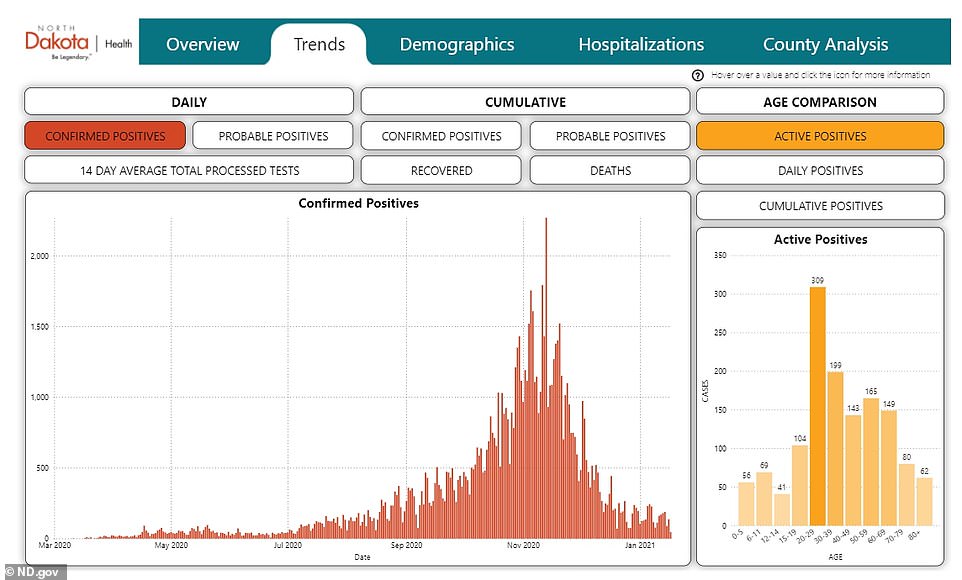
Active coronavirus cases have fallen by 80% and the number of new daily infections in the state is a fraction of what it had been a month ago when North Dakota was among the nation’s top hotspots
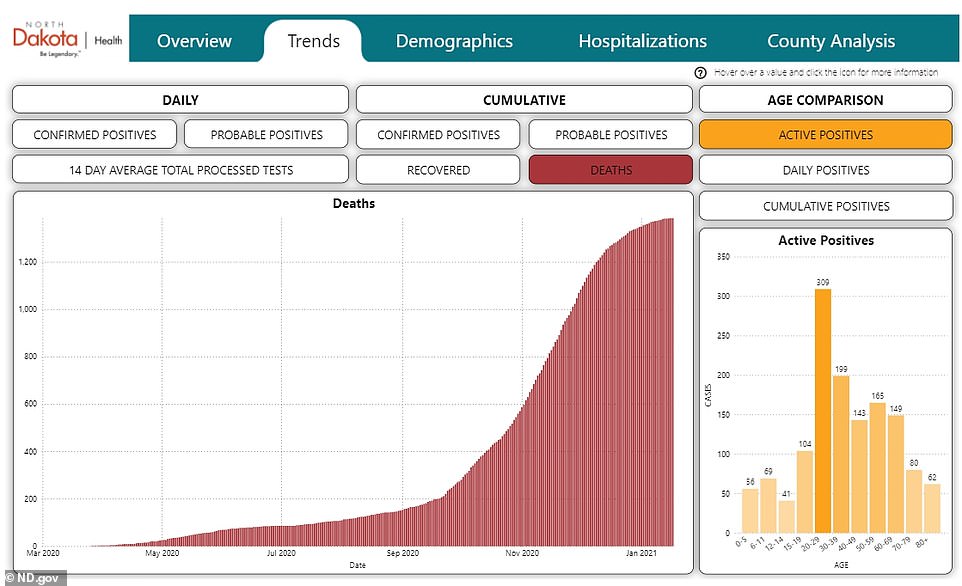
Cumulative deaths have increased in North Dakota, but the state has drastically bent the curve of fatalities since it climbed steeply last month, reaching a peak of 499 deaths in November, followed by 278 in December and 37 so far in January
North Dakota administered 3,222 vaccines on January 14 alone, according to its latest data. Nearly six percent of its population has had their first shot, and nearly one percent have already received their second.
Meanwhile, the state has 1,377 active cases of COVID-19 as of Monday – just a little over 10 percent as many as it saw at its November peak of 10,195.
Deaths in North Dakota continue to climb, but have leveled off since November.
Throughout much the nation, a game of federal and state he-said-she-said continues, and is doing little to speed the sluggish rollout.
Houston, Texas, officials say they are receiving sporadic shipments of small numbers of vaccine doses.
‘Right now, having (doses) one day and then running out, it just creates a lot of chaos,’ said Galveston County health director Dr Philip Keiser on Monday, according to Houston Public Media.
About 31.1 million doses of coronavirus vaccines have been sent to US states by the federal government, according to tracking from Bloomberg.
While West Virginia races to the head of the pack, vaccinating nearly nine percent of its population in just a month, California and Alabama rank worst, getting shots in the arms of just 3.3 percent and 2.7 percent of their residents, respectively.
Mass vaccination sites opened in larger states like New York, California and Florida, but rates of shot administration remain low.
Some of the states that have most vocally blamed the federal government for the vaccine rollout are among the slowest to use the doses sent to them.
California has vaccinated just 3.3 percent of its population and used a little over a third of its allotted doses, despite turning Disneyland and Dodger Stadium into ma
ss vaccination sites.
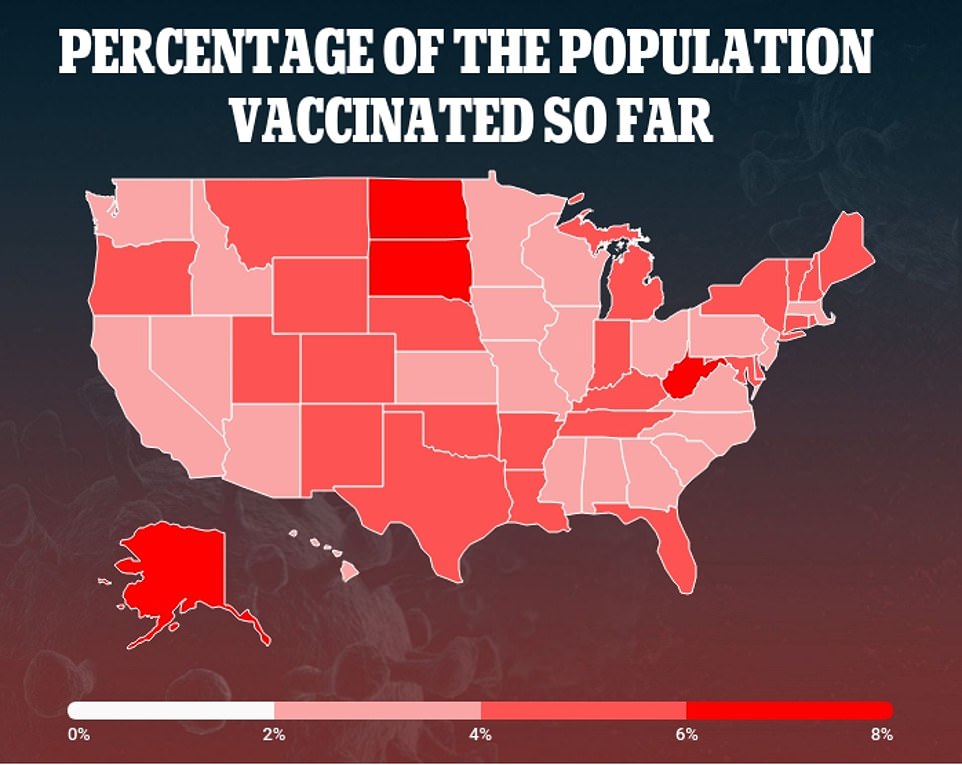
Only about 3% of Americans have gotten their first doses of coronavirus vaccines, with the highest rates in West Virginia and the Dakotas, and the lowest rates of vaccination are in Alabama and Arizona
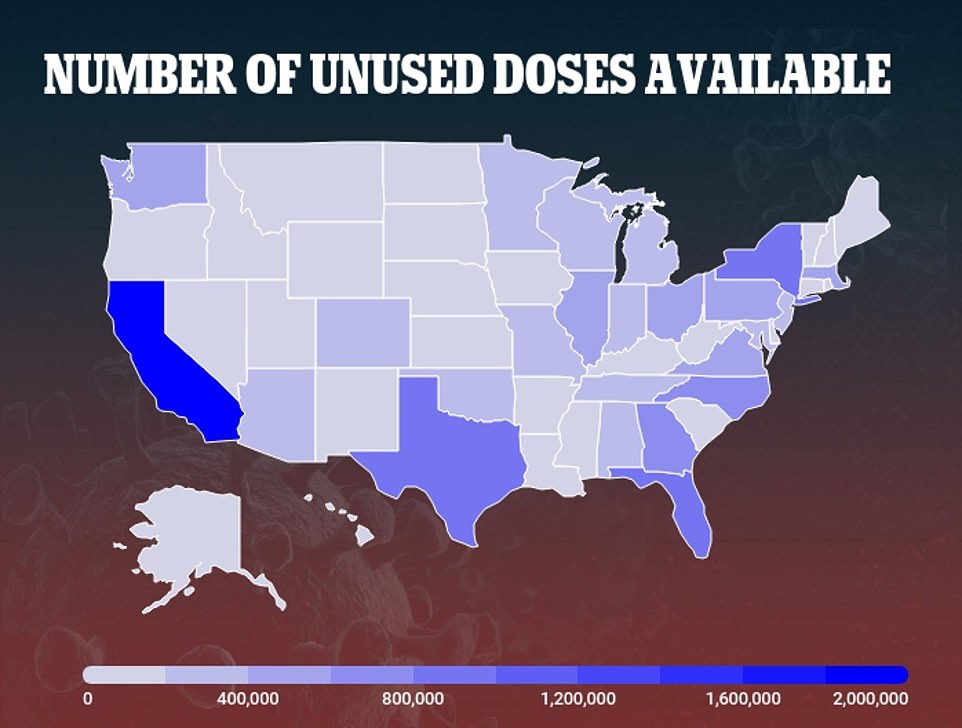
More than half of all doses of coronavirus vaccines distributed to US states are sitting on the shelves, with the highest rates of unused shots in California and Texas – despite the former being one of the worst hotspots for COVID-19 in the country
New York is faring a little better using up 53 percent of its doses and vaccinated about 5.4 percent of its population.
Southern and Sun Belt states are struggling. Alabama and Arizona have each vaccinated just 2.7 percent of their populations.
That’s particularly worrisome for Arizona, which has had more coronavirus infections per capita than any where else in the world.
The surprise leaders in the race remain West Virginia and the Dakotas.
West Virginia was the only state in the union turned down the federal government’s partnership with CVS and WalGreens to help vaccinate its nursing home residents.
And now it’s vaccinated 8.6 percent of its population – more than than any other states.
North and South Dakota have vaccinated nearly seven and 6.45 percent of their respective populations.
A senior federal official told DailyMail.com that the US will meet its goal of distributing 50 million doses to states this week.
But at this rate, it could be weeks before all of those doses make it into Americans’ arms.
States have given fewer than half of the doses the federal government has shipped – 46 percent – yet some say they are running out of doses.
Reports emerged last week that there was no federal stockpile of second doses to increase states’ supplies – after HHS Secretary Alex Azar promised that the reserve would be released – triggering panic.
Federal officials say that the number of doses made available to states each week has increased, but that the notion that the government ever had a stockpile was incorrect.
In fact, a senior administration official told DailyMail.com that some states are not completing all their orders for new doses each week, leaving them shorthanded.
Yet states, including Texas, say they’re on pace to run out of doses of vaccine by next week if they continue to administer as many as possible.

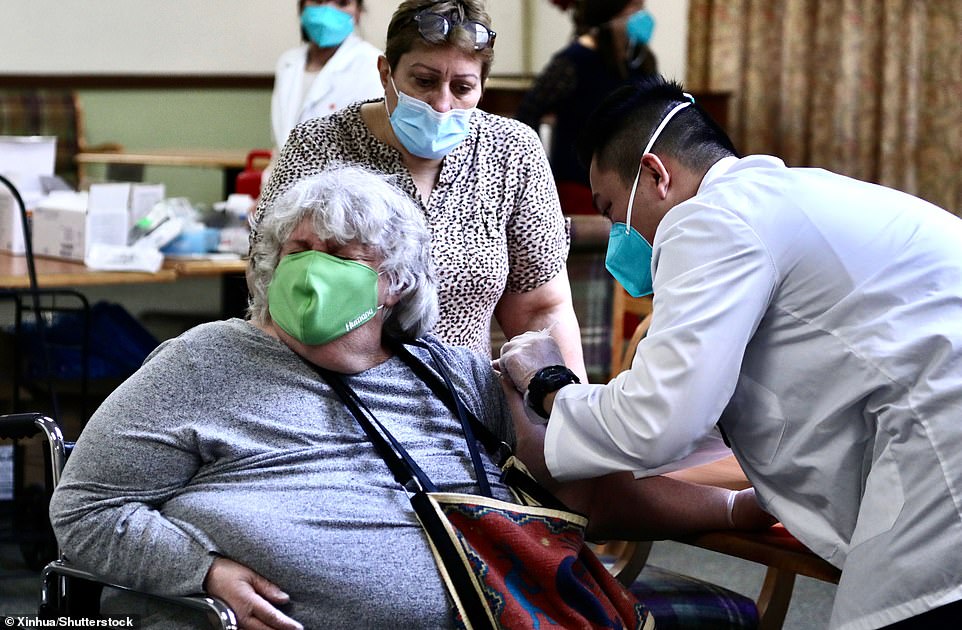
Los Angeles is among the worst hotspots for coronavirus in the US and health workers are racing to vaccinate at-risk people – including nursing home residents in Pasadena (pictured, file), but the state has used just 27.5% of its allotted doses
Since it began over a month ago, the US coronavirus vaccine rollout has been plagued by a game of federal and state ‘he said, she said,’ and little seems to have changed.
The emergence of more infectious coronavirus variants, including the UK’s ‘super-covid,’ should be a ‘clarion call’ to Americans to get vaccinated, said Dr Anthony Fauci during a Sunday Meet the Press appearance.
But the uptake has been slow.
Experts say yet another factor is holding up the rollout: ‘We’re underselling the vaccine’ Dr Aaron Richterman, an infectious disease specialist at the University of Pennsylvania told the New York Times.
He’s not alone in thinking that attempts to temper expectations and keep Americans from ripping of their masks as soon as they get their first doses of COVID-19 vaccines may be misguided.
‘It’s driving me a little bit crazy,’ Dr Ashish Jha of the Brown School of Public told the Times.
Vaccines made by both Moderna and Pfizer are more than 94 percent effective at preventing COVID-19, and that should be the focus of public messaging, the experts say.
That’s not to say that questions still being researched – such as rather the shots prevent infection or transmission altogether – should be concealed, nor that warnings about potential side effects shouldn’t be clear.
But, Dr Jha and Dr Richterman worry that the emphasis on what’s unknown is fueling hesitancy and slowing the uptake of shots.
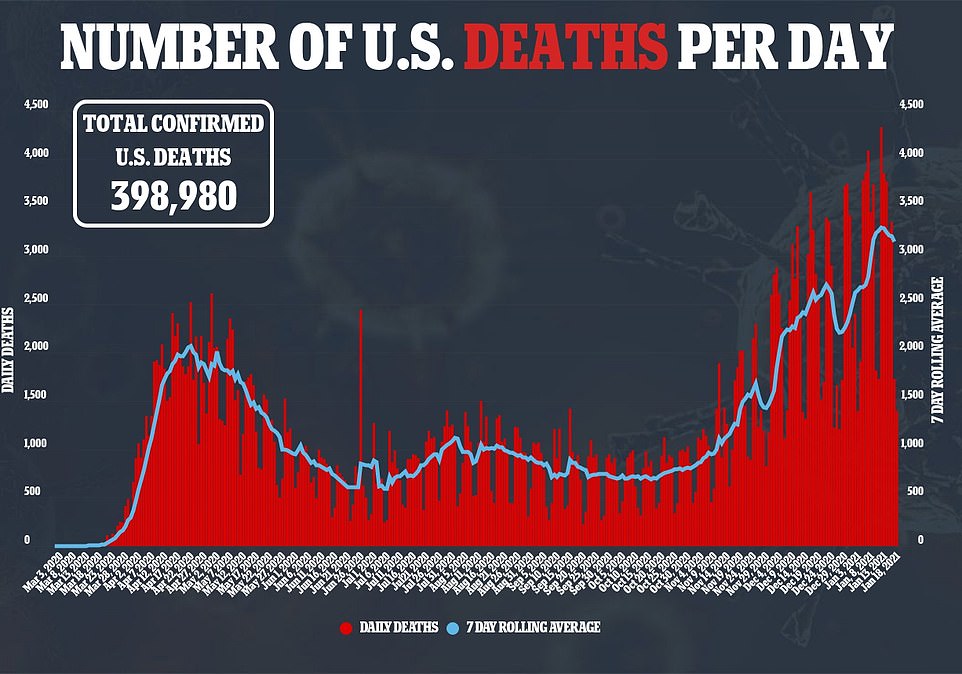

One California epidemiologist on Sunday called for Moderna to put a hold on 330,000 doses from one lot that have already been distributed after ‘fewer than 10’ people had possible severe allergic reactions to the shots within 24 hours.
Moderna, the FDA and the CDC are all investigating the incidences, but said in a statement to Fox News that vaccination is never without risks.
The reactions all happened within the observation period while the recipients were still at the vaccination site in San Diego.
Health care workers and nursing home residents were put first in line for coronavirus vaccines.
But during the first weeks of the rollout, staggering numbers of health care workers turned down the shots.
One Illinois veterans nursing home said that while about 90 percent of its elderly residents had said ‘yes’ to the shot, some 80 percent of staff had said ‘no.’
Nurses in Texas and California – two of the nation’s worst hotspots for COVID-19 – said they and about half of their colleagues planned to refuse or delay vaccination.
In New York, four doses of vaccine had to be thrown out because willing recipients working in health care could not be found in time to use the shots before they expired.
Amid suspicion that resistance among health care workers and rigid state plans for who could be vaccinated when were the problem, federal officials urged vaccination to be opened up to people 65 and older.
